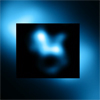CXC Home | Search | Help | Image Use Policy | Latest Images | Privacy | Accessibility | Glossary | Q&A
Tour of NGC 3393
Quicktime MPEG
Astronomers using NASA's Chandra X-ray Observatory have discovered the first pair of supermassive black holes in a spiral galaxy similar to the Milky Way. These black holes were found in the galaxy NGC 3393, which is located about 160 million light years from Earth. This is the view of NGC 3393 from both Chandra and the Hubble Space Telescope. Zooming in further, we see what the center of the galaxy looks like in just X-rays. The two peaks of X-ray emission are, in fact, black holes that are actively growing. They glow in X-rays as gas falling toward the black hole gets hotter. Separated by only 490 light years, the black holes in NGC 3393 are likely the remains of a galactic merger that took place a billion or more years ago.
[Runtime: 01:02]
Quicktime MPEG
Astronomers using NASA's Chandra X-ray Observatory have discovered the first pair of supermassive black holes in a spiral galaxy similar to the Milky Way. These black holes were found in the galaxy NGC 3393, which is located about 160 million light years from Earth. This is the view of NGC 3393 from both Chandra and the Hubble Space Telescope. Zooming in further, we see what the center of the galaxy looks like in just X-rays. The two peaks of X-ray emission are, in fact, black holes that are actively growing. They glow in X-rays as gas falling toward the black hole gets hotter. Separated by only 490 light years, the black holes in NGC 3393 are likely the remains of a galactic merger that took place a billion or more years ago.
[Runtime: 01:02]
(Credit: NASA/CXC/A. Hobart)
X-ray and Optical Images of NGC 3393
Quicktime MPEG
This sequence shows images of NGC 3393, a spiral galaxy with a pair of supermassive black holes likely left behind after a merger with another galaxy. The first image is a composite of X-rays from Chandra (blue) and optical data from the Hubble Space Telescope (orange and yellow). Zooming into the galaxy’s central region, the view transitions to observations from only Chandra. Two separate peaks of X- ray emission (roughly at 11 o'clock and 4 o'clock) can clearly be seen. These two sources are actively growing black holes a mere 490 light years apart. Because X-rays are generated as gas falls towards the black holes and becomes hotter, astronomers were able to detect the black holes in the Chandra data.
[Runtime: 00:20]
Quicktime MPEG
This sequence shows images of NGC 3393, a spiral galaxy with a pair of supermassive black holes likely left behind after a merger with another galaxy. The first image is a composite of X-rays from Chandra (blue) and optical data from the Hubble Space Telescope (orange and yellow). Zooming into the galaxy’s central region, the view transitions to observations from only Chandra. Two separate peaks of X- ray emission (roughly at 11 o'clock and 4 o'clock) can clearly be seen. These two sources are actively growing black holes a mere 490 light years apart. Because X-rays are generated as gas falls towards the black holes and becomes hotter, astronomers were able to detect the black holes in the Chandra data.
[Runtime: 00:20]
(Credit: NASA/CXC/A. Hobart)
Return to NGC 3393 (August 31, 2011)




